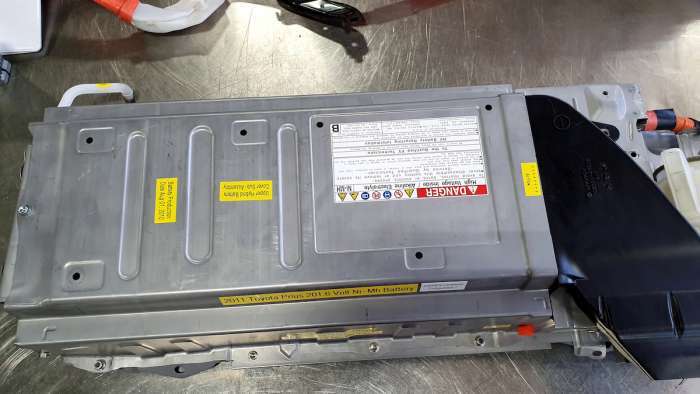A P0A80 Trouble code is one that no Prius (or other hybrid owners) ever wants to encounter. The dreaded battery code of doom spells more than certain destruction; it spells money out of your pocket.
While I cannot help you financially with your battery, I can help you learn about it for free. I have given several dissertations on battery repair, replacement, and reconditioning over my time as an automotive professional.
I use the word dissertation because what I am about to explain pretty much requires a doctorate degree to understand. So instead, I want to dive into how Toyota hybrids know when to set trouble codes.
In this article, we will talk about 3 things. A coulomb counter, state of charge, and battery capacity. I hope that I can accurately explain the system to benefit Prius and other hybrid owners.
What Is A Coulomb Counter?
Loosely explained, a coulomb counter is like an odometer for electrical current. It measures the flow of current (amps) and pulses a signal to the computer after a set amount of time to know how much current has flowed over time.
Knowing this information helps a system know what the given state of charge is for the monitored battery.
What Is State Of Charge?
State of charge or SOC is the amount of charge a battery has typically given in a percent. For example, 100% SOC would mean the battery is fully charged according to the system that monitors the battery.

A more accurate state of charge is defined at the ratio between available capacity and the maximum possible charge stored in a battery.
100% SOC does not always mean the battery is fully charged, though. For example, with nickel-metal hydride or NiMH commonly found in Toyota hybrid products, 100% charge only represents 80% SOC in the battery itself.
Why is this? The NiMH chemistry functions best within a "window" or a specified range of charge/discharge where it can provide the electricity needed while maintaining long life. If we allowed NiMH to be fully charged and discharged, we would see a short-term gain with a long-term loss. The battery life would be severely reduced, meaning it would be changed far more often.
What Is Battery Capacity?
Battery capacity or Amp Hours is determined by the amount of active material inside the battery. Think of different-sized buckets. Each bucket has a capacity (typically found in gallons if you are in the U.S.), and that available storage could be poured out at a rate (amps) over time (amp hours).

That is the simplest way I can think to explain it. But, of course, anyone who knows electricity will have their own way of thinking about batteries and capacity. So my goal here is to explain as easily as I can what all of this means for your Toyota Prius (or other hybrids) battery.
What Does All This Mean?
Knowing how our hybrid batteries are measured is one part of the enigma. With a good battery that has a maximum capacity, it will not set trouble codes. A failing battery will charge trouble codes, but why does it set a code if the coulomb counter measures flow?
Remember, SOC is determined by the available capacity. Think about it this way. What if you took a 5-gallon bucket and filled it halfway with sand, then put water in it. Would you get the same 5 gallons of water going in? Unfortunately, no, and the reason is that the capacity is reduced due to the sand.
Batteries have a similar thing happen where capacity reduces (not caused by sand), and the computer determines the available capacity to be less. As the electrons flow out and the SOC of the battery is measured, the faster it drops, the less capacity it has.
The measurement is calculated, and if it falls outside the parameters set forth by the programming in the battery management system, a trouble code is set. Finally, the check hybrid system light is illuminated.
In short, the reduced capacity measured by the coulomb counter that measures the amps flowing will determine the available capacity in the battery and determine if it fits the criteria to either set a trouble code or not.
Conclusion
A battery can be in failure but not wholly failed due to the programming inside the BMS (battery management system). Careful inspection and watching how fast the battery drains and refills will give you an idea of how well your battery is performing. The faster it drains and fills means the closer it is to the end of its life.
Now one more thing before I sign off on this article. People ask me why they cannot run a larger amp hour battery and why with Prius specifically, we are stuck with 6.5ah modules.
It is because the BMS limits how much electricity can flow out of that battery. Once the counter has seen enough electrons flow over its set time frame, it will automatically kick on the engine to recharge the battery. But what about the famed Lithium battery? Why is it better than NiMH?
While there are many reasons, the biggest one is that it can effectively store more energy than NiMH. As a result, it has a more stable response with loads (passing, hills, etc.). When you have a constant flow of electricity, your vehicle can perform at its peak all the time.
NiMH and specially aged NiMH fall off the curve much quicker than LiFePo and hence is a better replacement battery if you plan to keep the Prius for a long time.
That wraps it up. If you have more questions or want to talk more about battery tech, please drop a message below. Remember Today's Adventure is Tomorrow's Story.
Want to know more about Prius camping with some cool gear? Take a look.
Check out this wild new battery tech that Tesla has and why it will forever change the auto industry.
Also, watch Toyota suddenly bringing its BZ4X electric SUV concept to United States on Torque News Youtube channel and please subscribe us on Youtube and follow on Twitter for daily Toyota and EV news reports.
Peter Neilson is an automotive consultant specializing in electric cars and hybrid battery technologies. He holds a Bachelor of Science in Automotive Service Technology from Weber State University. Peter can be reached on Linkedin and you can tweet him at The_hybrid_guy on Twitter. Find his page on Facebook at Certified Auto Consulting. Read more of Peter's stories at Toyota news coverage on Torque News. Search Toyota Prius Torque News for more in depth Prius coverage from our reporter.












Comments
My original hybrid battery-
Permalink
My original hybrid battery- prius 2013 is charging more often, almost every day ... one cycle up to 100% instead of 80. Is it the beginning of end?
Where is the cheapest place…
Permalink
Where is the cheapest place
To purchase a new 2015 Prius battery!